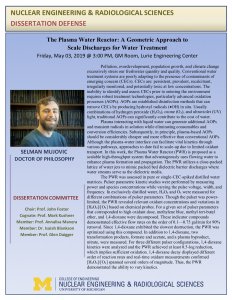Presented By: Nuclear Engineering & Radiological Sciences
PhD Defense: Selman Mujovic
The Plasma Water Reactor: A Geometric Approach to Scale Discharges for Water Treatment

Title: The Plasma Water Reactor: A Geometric Approach to Scale Discharges for Water Treatment
Chair: Prof. John Foster
Abstract: Pollution, overdevelopment, population growth, and climate change excessively stress our freshwater quantity and quality. Conventional water treatment systems are poorly adapting to the presence of contaminants of emerging concern (CECs). CECs are: persistent, prevalent, recalcitrant, irregularly monitored, and potentially toxic at low concentrations. The inability to identify and assess CECs prior to entering the environment requires robust treatment technologies, particularly advanced oxidation processes (AOPs). AOPs are established disinfection methods that can remove CECs by producing hydroxyl radicals (•OH) in situ. Usually combinations of hydrogen peroxide (H2O2), ozone (O3), and ultraviolet (UV) light, traditional AOPs can significantly contribute to the cost of water.
Plasma interacting with liquid water can generate additional AOPs and transient radicals in solution while eliminating consumables and conversion efficiencies. Subsequently, in principle, plasma-based AOPs should be considerably cheaper and more effective than conventional AOPs. Although the plasma-water interface can facilitate vital kinetics through various pathways, approaches to date fail to scale-up due to limited oxidant transport. In this work, the Plasma Water Reactor (PWR) is proposed as a scalable high-throughput system that advantageously uses flowing water to enhance plasma formation and propagation. The PWR utilizes a close-packed lattice of water jets to mimic packed bed dielectric barrier discharges where water streams serve as the dielectric media.
The PWR was assessed in pure or single-CEC-spiked distilled water matrices. Pulser parametric kinetic studies were performed by measuring power and species concentrations while varying the pulse voltage, width, and frequency. In exclusively distilled water, H2O2 and O3 were measured for different combinations of pulser parameters. Though the pulser was power- limited, the PWR revealed relevant oxidant concentrations and variations in [H2O2]/[O3] based on chemical probes. For a given set of pulser parameters that corresponded to high oxidant dose, methylene blue, methyl tert-butyl ether, and 1,4-dioxane were decomposed. These indicator compounds demonstrated effective flow rates on the order of 0.1—0.75 gal/min for 90% removal. Since 1,4-dioxane exhibited the slowest destruction, the PWR was optimized using this compound. In addition to 1,4-dioxane, two transformation products, formate and acetate, and a plasma byproduct, nitrate, were measured. For three different pulser configurations, 1,4-dioxane kinetics were analyzed and the PWR achieved at least 0.5-log reduction, which implies sufficient oxidation. 1,4-dioxane decay displayed different order of reaction rates and real-time oxidant measurements confirmed [H2O2]/[O3] spanned several orders of magnitude. Thus, the PWR demonstrated the ability to vary kinetics.
Chair: Prof. John Foster
Abstract: Pollution, overdevelopment, population growth, and climate change excessively stress our freshwater quantity and quality. Conventional water treatment systems are poorly adapting to the presence of contaminants of emerging concern (CECs). CECs are: persistent, prevalent, recalcitrant, irregularly monitored, and potentially toxic at low concentrations. The inability to identify and assess CECs prior to entering the environment requires robust treatment technologies, particularly advanced oxidation processes (AOPs). AOPs are established disinfection methods that can remove CECs by producing hydroxyl radicals (•OH) in situ. Usually combinations of hydrogen peroxide (H2O2), ozone (O3), and ultraviolet (UV) light, traditional AOPs can significantly contribute to the cost of water.
Plasma interacting with liquid water can generate additional AOPs and transient radicals in solution while eliminating consumables and conversion efficiencies. Subsequently, in principle, plasma-based AOPs should be considerably cheaper and more effective than conventional AOPs. Although the plasma-water interface can facilitate vital kinetics through various pathways, approaches to date fail to scale-up due to limited oxidant transport. In this work, the Plasma Water Reactor (PWR) is proposed as a scalable high-throughput system that advantageously uses flowing water to enhance plasma formation and propagation. The PWR utilizes a close-packed lattice of water jets to mimic packed bed dielectric barrier discharges where water streams serve as the dielectric media.
The PWR was assessed in pure or single-CEC-spiked distilled water matrices. Pulser parametric kinetic studies were performed by measuring power and species concentrations while varying the pulse voltage, width, and frequency. In exclusively distilled water, H2O2 and O3 were measured for different combinations of pulser parameters. Though the pulser was power- limited, the PWR revealed relevant oxidant concentrations and variations in [H2O2]/[O3] based on chemical probes. For a given set of pulser parameters that corresponded to high oxidant dose, methylene blue, methyl tert-butyl ether, and 1,4-dioxane were decomposed. These indicator compounds demonstrated effective flow rates on the order of 0.1—0.75 gal/min for 90% removal. Since 1,4-dioxane exhibited the slowest destruction, the PWR was optimized using this compound. In addition to 1,4-dioxane, two transformation products, formate and acetate, and a plasma byproduct, nitrate, were measured. For three different pulser configurations, 1,4-dioxane kinetics were analyzed and the PWR achieved at least 0.5-log reduction, which implies sufficient oxidation. 1,4-dioxane decay displayed different order of reaction rates and real-time oxidant measurements confirmed [H2O2]/[O3] spanned several orders of magnitude. Thus, the PWR demonstrated the ability to vary kinetics.
Explore Similar Events
-
Loading Similar Events...
